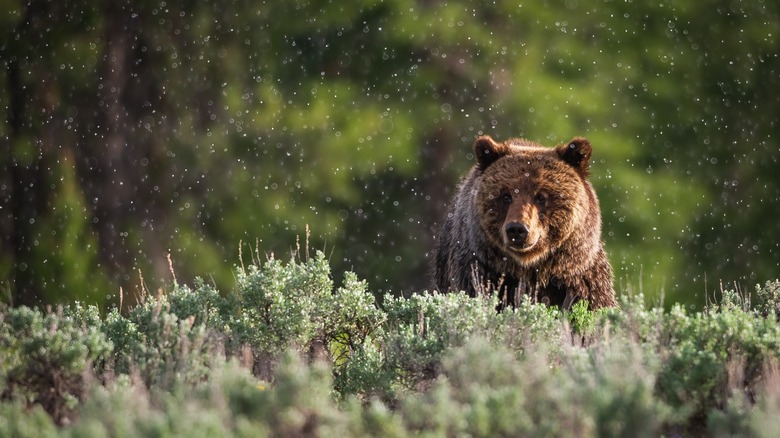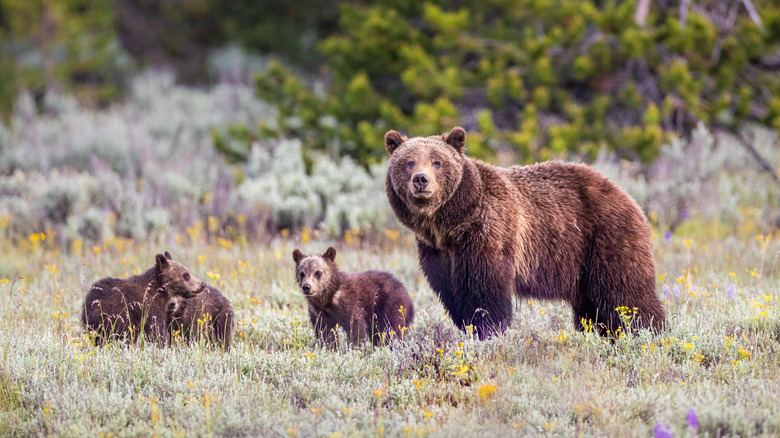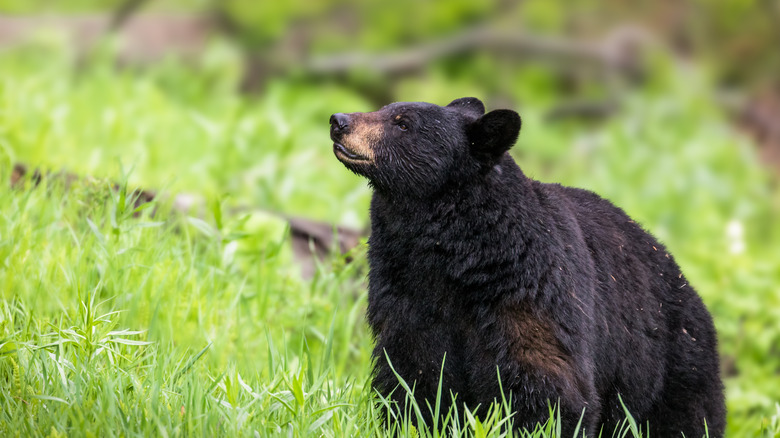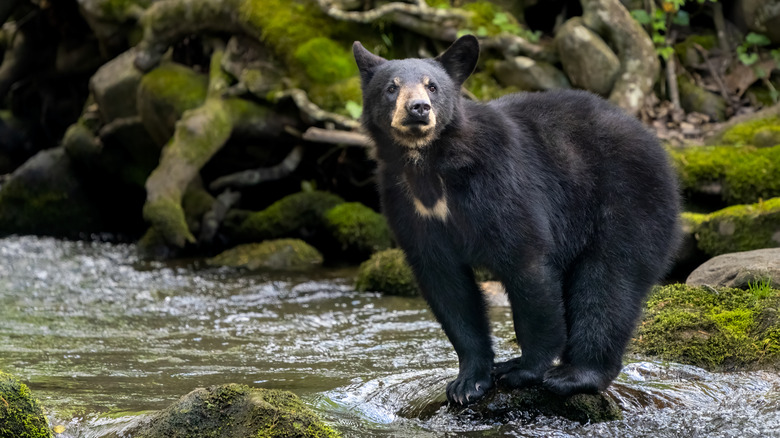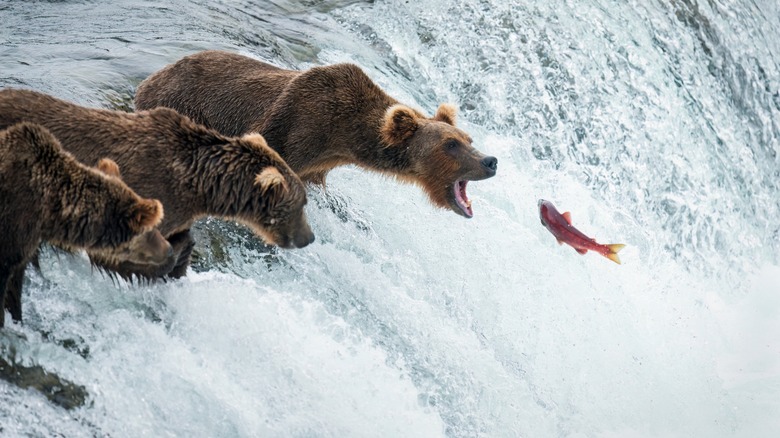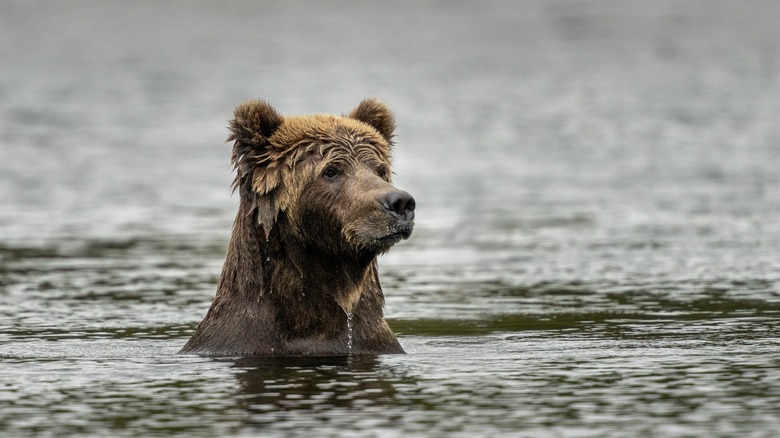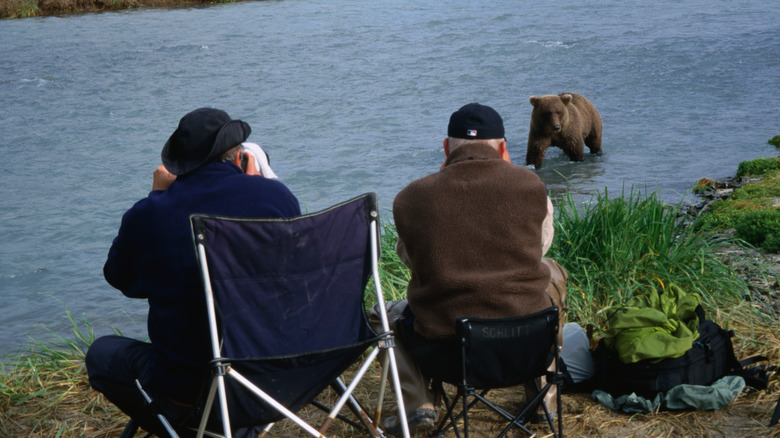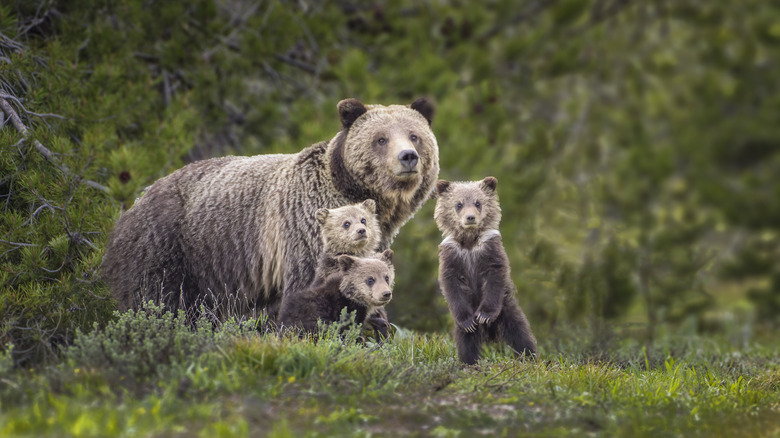The Safest Destinations In America To Spot Bears In Their Natural Habitat
For most nature enthusiasts, the opportunity to watch bears roam freely in their natural environment sounds like the experience of a lifetime. After all, seeing these powerful creatures fish for salmon, forage for berries, and teach their cubs how to explore and survive is what the wildest NatGeo dreams are made of. Luckily, those dreams don't have to stay just ... well, dreams. From Tennessee to Alaska, there are plenty of national parks in the U.S. for a safe bear-watching experience — all of which are guaranteed to be memorable.
In terms of bear population, the United States is home to three native species. First, there are black bears. Dominating the eastern coast, the local black bear population is made up of roughly 300,000. Then, you've got brown bears (including grizzly bears). Generally confined to western states, there are currently around 30,000 brown bears roaming the wilderness. Finally, tucked away in the great Alaskan wilderness, polar bears thrive — with somewhere between 4,000 and 7,000 bears in total.
After scouring through dedicated websites and official National Park documentation, we settled on five destinations that bear lovers and outdoor enthusiasts simply can't skip on their quest for the perfect bear sighting. So whether you're exploring the dense valleys of Yellowstone National Park or watching bears hunt for salmon in the pristine waters of Katmai National Park, we're here to help you choose the perfect destination to catch a glimpse of how these incredible animals live, thrive, and interact all across their diverse habitats.
Grand Teton National Park, Wyoming
Kicking things off on our list of the best places to spot bears in the U.S. is the always-spectacular Grand Teton National Park. Home to rugged peaks, breathtaking hikes, and beautiful mountainside lakes that look plucked straight out of a postcard, Grand Teton serves as a wildlife sanctuary.
Located roughly 12 miles outside the town of Jackson, on the northwestern side of Wyoming, the park's diverse landscape makes it a prime bear-watching destination. Considering the area is home to around 700 grizzlies and 500 black bears, your chances of spotting these creatures are particularly high, especially during spring and early summer when males and females start to crawl out of hibernation.
To spot the bears, you'll want to focus on several key areas within the park. Willow Flats, north of the Snake River, is one of the best spots to see grizzlies. Additionally, the Teton Park Road — specifically the stretch between Jenny Lake and Signal Mountain — also provides excellent roadside viewing opportunities where you can safely watch from inside your car. Alternatively, for a more secluded experience, head to Two Ocean and Emma Mathilda Lakes in the park's northeast corner, where bears often visit the lush shoreline.
Yellowstone National Park, Wyoming
Just north of Grand Teton, Yellowstone National Park steals the spotlight as one of America's top bear-watching destinations. Covering a whopping 3,472 square miles, the park extends beyond Wyoming into Montana and Idaho. Home to an estimated 950 grizzlies and over 500 black bears, the expansive park is brimming with opportunities to see bears safely and responsibly.
With its open meadows and dense forests to river valleys teeming with wildlife, the park's diverse landscape creates the perfect bear-watching conditions. Plus, along with grizzlies and black bears, you might also catch a glimpse of other local wildlife, including elk, wolves, bison, and coyotes.
In terms of locations, the most reliable viewing spots include Lamar Valley — known as a prime wildlife haven — and Hayden Valley, where visitors can safely observe bears from designated overlooks. Specifically, the Slough Creek Trail is often celebrated as one of Yellowstone Park's hikes with the most bear sightings in the country. Located west of the Lamar Valley, in the Tower-Roosevelt area, this 9-mile round-trip hike winds through meadows where both brown and black bears frequently roam. If you're hoping for black bears specifically, the Tower-Roosevelt area (nicknamed the "Bear-muda Triangle") is buzzing with frequent sightings, especially during spring and early summer.
Great Smoky Mountains National Park, Tennessee & North Carolina
Straddling the border between North Carolina and Tennessee, Great Smoky Mountains National Park stands out as the black bear capital of the eastern United States. With approximately 1,900 bears roaming across more than 500,000 acres, the park maintains one of the highest bear densities in North America — about two bears per square mile. From dense forests to mountain peaks, the diverse landscape provides perfect conditions for its thriving bear population.
Unlike the western parks, the Great Smoky Mountains is exclusively reserved for black bear sightings. Some of the park's best viewing spots include Cades Cove, where bears often peek through the open valleys, and the Roaring Fork Motor Nature Trail, a 5.5-mile loop that's ideal for early morning or evening wildlife watching. Alternatively, for a unique experience, visit the Gregory Bald area in August, when black bears gather round to feast on wild blueberries as they prepare for winter.
As a general rule, bears typically emerge from hibernation in late March or early April. However, Great Smoky Mountain bears are a little different from their northern cousins: Unlike bears in colder regions that enter true hibernation with decreased body temperature and slowed metabolism, Smoky Mountain black bears enter a lighter sleep state instead. This is due to the region's milder winters, which means these bears often wake up during warm spells and can be spotted roaming the park even in winter months — although sightings are less frequent.
Katmai National Park & Preserve, Alaska
Home to an estimated 2,200 brown bears, Katmai National Park and Preserve is one of Alaska's top destinations for incredible views of wildlife. Nestled near the base of Mount Katmai and its active volcano, this vast wilderness area boasts some of the country's most reliable opportunities to see bears in their natural habitat. This, primarily thanks to the abundance of sockeye salmon runs available for bears to feast on.
Specifically, Brooks Falls serves as the park's main attraction. There, visitors can watch up to 50 bears at once fishing for salmon from designated viewing platforms. And while the viewing platforms can get crowded — especially during peak season from June to September — the experience of watching these skilled hunters at work is definitely worth the wait and the crowds.
Beyond Brooks Falls, the park's Pacific coast also boasts a high concentration of bears, which visitors can observe on guided tours or self-guided visits, with park rangers on site to ensure everyone's safety. Can't make the trip in person? No need to worry — you can still get your fill of fishing bears and salmon acrobatics. With livestreams across six areas of the park, Katmai National Park and Preserve's ultra-popular "bear cams" offer a front-row seat to all of the excitement from the comfort of your own home.
Kodiak National Wildlife Refuge, Alaska
Located in southwestern Alaska's Kodiak Archipelago, the Kodiak National Wildlife Refuge is one of the best-kept secret destinations in the state and offers visitors a chance to see the world's largest brown bears in their natural habitat. Home to approximately 3,500 of them, these massive creatures have evolved in isolation for the past 12,000 years, ultimately developing into a distinct subspecies from mainland brown bears.
The refuge's rich ecosystem — filled with salmon runs and abundant berries — provides the perfect conditions for these bears to thrive. And although spotting bears from the road system is possible, the most reliable way to see them is by joining one of the area's guided floatplane trips that'll take you to prime viewing locations like Frazer Lake. From there, a short three-quarter-mile hike will lead you to designated viewing areas where bears frequently gather to fish for their dinner.
Planning-wise, you'll ideally want to head to Kodiak National Wildlife Refuge from July through September, when the salmon runs attract hungry bears preparing for winter. Local air charter companies and tour operators offer half-day viewing trips, while more adventurous visitors can book overnight experiences at one of the remote lodges.
Safety precautions to keep in mind while bear-spotting
Although most national parks generally make it quite safe for visitors to catch a glimpse of the local bear population, there's one major factor that determines whether or not your bear-watching experience will be successful — and it's all to do with understanding and following basic safety protocols. This includes always maintaining a safe distance (at least 300 feet), moving in groups, and never approaching or feeding the bears (or any other wild animal for that matter). Most parks even offer designated viewing platforms designed to ensure both visitor safety and wildlife protection. If you do happen to unexpectedly run into a bear while hiking at any of these or other destinations, remember to always stay calm, try and make yourself appear large, and slowly back away while keeping the bear in sight.
Ultimately, while the thrill of seeing these animals in their natural habitat can be exciting, human and animal safety should always come first. And no matter how "friend-shaped" bears might look, it's important to remember that wild bears are actually not that friendly at all — and that encroaching on their or their cubs' space can lead to some pretty dangerous and deadly circumstances.
Our methodology
In order to land on our list of America's top bear-watching destinations, we focused primarily on sources that included National Park Service reports, as well as firsthand experiences from travelers who had visited these locations. That way, we were able to pinpoint a list of locations that offered consistent bear sightings, maintained proper safety protocols, and focused on animal and human wellbeing.
Ultimately, our selections were based on several key factors including documented bear population numbers and density, reliable sighting information, and overall safety infrastructure that didn't put anyone in harm's way. These five destinations consistently ranked highest across all sources — although not necessarily in the same order — for offering visitors the best combination of reliable sightings and safe viewing conditions.
